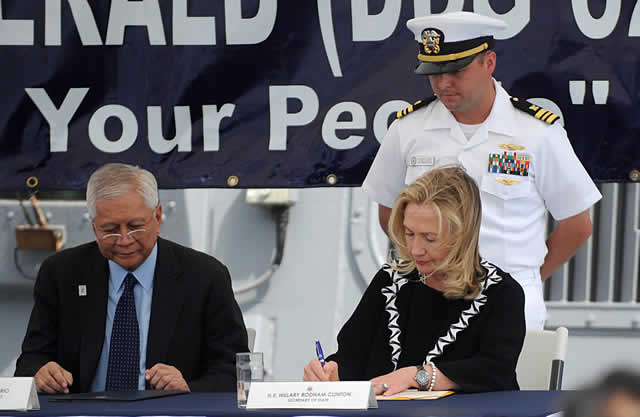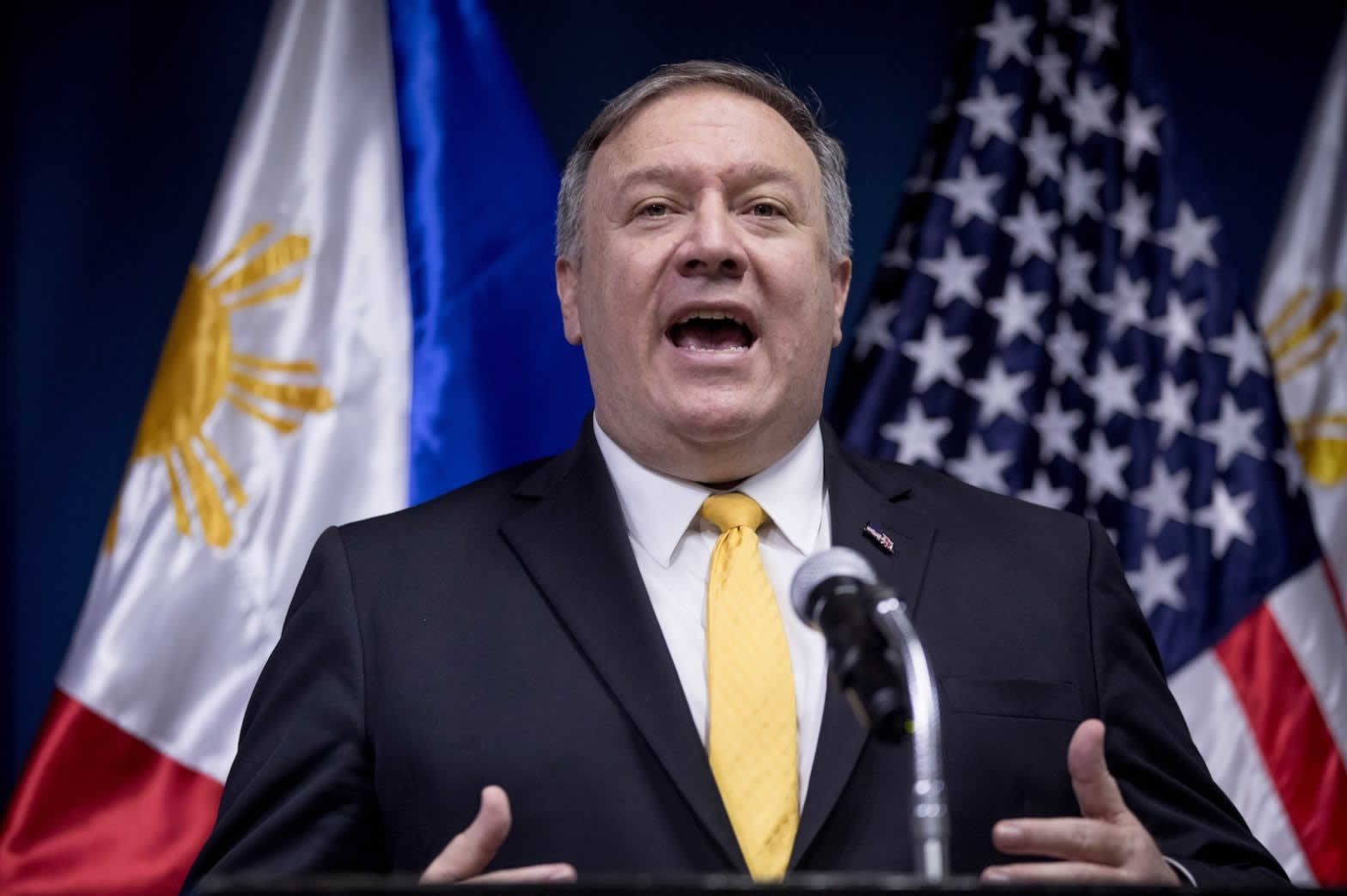|

Philippine President Elpidio Quirino (center) pays an Oval Office visit to US President Harry Truman (left). Philippine Ambassador to the US, Joaquín Miguel Elizalde stands behind Quirino. Photo: Truman Library

n August 30, 1951 the Mutual Defense Treaty (MDT) between the Philippines and the United States was signed. America at that time was the undisputed global superpower while the Philippines, its former colony, was one of its closest allies and most ardent supporter. Philippine President Elpidio Quirino and US President Harry Truman affixed their signatures to the document in the White House. The treaty was subsequently ratified by both the US and Philippine legislatures in early 1952, and it took effect on the 27th of August 1952.
For over half a century since that Oval Office signing, the Philippines, for the most part, lived in peace with its neighbors. On two occasions, as a staunch US ally, the country sent military contingents to support US military campaigns, first during the Korean War, with the Philippine Expeditionary Forces to Korea (PEFTOK), and later during the Vietnam War, with the Philippine Civic Action Group (PHILCAG).
To commemorate the 60th anniversary of the treaty, the United States and the Philippines reaffirmed the MDT with what is now known as the Manila Declaration. On November 16, 2011, aboard the destroyer USS Fitzgerald, docked in Manila Bay, Philippine Foreign Secretary Alberto Del Rosario and U.S. Secretary of State Hillary Clinton signed a declaration that states, in part: “The Republic of the Philippines and the United States reaffirm our shared obligations under the Mutual Defense Treaty. We expect to maintain a robust, balanced, and responsive security partnership including cooperating to enhance the defense, interdiction, and apprehension capabilities of the Armed Forces of the Philippines. The Republic of the Philippines and the United States of America today commemorate the 60th anniversary of the Philippines-U.S. Mutual Defense Treaty. On this historic occasion, we reflect on the rich history of our alliance and the continuing relevance of the treaty for peace, security, and prosperity in the Asia-Pacific region. We also reaffirm the treaty as the foundation of our relationship for the next 60 years and beyond.”

Former US Secretary of State Hillary Clinton (R), beside former Foreign Affairs Secretary Alberto del Rosario (L), sign the the Manila Declaration aboard the USS Fitzgerald, on November 16, 2011. Photo: Dailysignal.com
In her remarks during the event, Secretary Clinton added, “we will always stand and fight with you to achieve the future we seek.” Robert Warshaw reporting for The Heritage Foundation’s The Daily Signal news website noted that Clinton’s comments were “a serious commitment on the part of the U.S. We have to stand by it.”
Five months before Del Rosario and Clinton signed the Manila Declaration, then-US Ambassador Harry Thomas was quoted in a Wall Street Journal article on June 15, 2011, to have said that "I want to assure you that on all sectors, we, the United States, are with the Philippines, ... The Philippines and the United States are strategic treaty allies. We are partners. We will continue to consult and work with each other on all issues, including the South China Sea.”
Unfortunately, just five months after the signing, the standoff between the Philippines and China at Panatag (Scarborough) Shoal happened. Wikipedia notes that “on April 10, 2012, BRP Gregorio del Pilar came to inspect the catch of the fishing vessels. The Filipino inspection team claimed that they discovered illegally collected corals, giant clams and live sharks inside the first vessel boarded by the team. BRP Gregorio del Pilar reported that they attempted to arrest the Chinese fishermen but were blocked by Chinese maritime surveillance ships, China Marine Surveillance 75 (Zhongguo Haijian 75) and China Marine Surveillance 84 (Zhongguo Haijian 84).” Panatag Shoal, it must be pointed out is just 124 nautical miles from the Zambales shoreline—well within the Philippines’ 200-mile exclusive economic zone (EEZ), as delineated by the United Nations Convention on the Law of the Sea (UNCLOS).
Throughout the standoff, the United States government, taking its marching orders from the Barack Obama administration fell eerily silent. The first-term neophyte senator who made it into the White House appeared to lack the appreciation for the long-standing ties between both countries and failed to fully grasp the long-term consequences of what the Chinese were up to. The US ambassador and secretary of state told Filipinos, that because of the MDT, America had their backs. but when push-came-to-shove, Obama stuck his head in the sand and did nothing. In a just-published article in the Asia Times, Richard Heydarian points out that "on multiple occasions, then-president Barack Obama and his senior officials dismissively described the disputes as unnecessary squabbling over a 'bunch of rocks.'"
The US defense establishment on the other hand, was deeply concerned about what was happening in the South China Sea. Intelligence report after intelligence report pointed to the fact that China was creating a very dangerous situation not just for countries in the region, but for the United States as well. American defense officials wanted to commence freedom of navigation operations (FONOPs) in the South China Sea but the Obama administration objected to anything that might ruffle Chinese feathers—never mind that China was trampling on the rights of other countries like the Philippines which has competing claims in that sea.
A September 26, 2016 article by David B. Larter in the Navy Times, revealed that “The U.S. military's top commander in the Pacific [was] arguing behind closed doors for a more confrontational approach to counter and reverse China's strategic gains in the South China Sea, appeals that have met resistance from the White House at nearly every turn. Adm. Harry Harris [was] proposing a muscular U.S. response to China's island-building that may [have included] launching aircraft and conducting military operations within 12 miles of these man-made islands, as part of an effort to stop what he has called the "Great Wall of Sand" before it extends within 140 miles from the Philippines' capital, sources say. Harris and his U.S. Pacific Command have been waging a persistent campaign in public and in private over the past several months to raise the profile of China's land grab, accusing China outright in February of militarizing the South China Sea.”
Unfortunately, the Obama administration’s response to the admiral’s concerns was to “tamp down on rhetoric from Harris and other military leaders, who [were] warning that China [was] consolidating its gains to solidify sovereignty claims to most of the South China Sea.” The Navy Times noted that Obama’s National Security Adviser Susan Rice even “imposed a gag order on military leaders over the disputed South China Sea,” preventing them from discussing the issue in public.
Now, “US President Donald Trump’s administration has explicitly reaffirmed its obligations to the Philippines under their 1951 Mutual Defense Treaty (MDT)” Heydarian writes. “US Secretary of State Mike Pompeo said on March 1 during a visit to Manila that his country would defend the Philippines if it came under attack from China in relation to a years-long island dispute in the South China Sea. Pompeo said after meeting with Foreign Secretary Teodoro Loscin that any armed Chinese attack on Philippine forces, aircraft or public vessels in the South China Sea would trigger mutual defense obligations under the treaty’s Article 4.”

US Secretary of State Mike Pompeo speaking in a Manila news conference on March 1, 2019. Photo:AFP/Andrew Harnik/Poo
The Asia Times article notes that “it marked the first time the US had explicitly said it would defend the Philippines’ position in the contested South China Sea. Pompeo’s shift is a reflection of Washington’s increasingly adversarial relations with Beijing, as well as US concerns over Manila’s recent call for a “review” of the MDT, a process some believe could lead to the treaty’s eventual abrogation.”
A review and possible abrogation is exactly what Philippine Defense Secretary Delfin Lorenzana is pushing for. Wanting his cake and eating it too, Lorenzana argues that the US and China could likely get into a shooting war and if the Philippines has a mutual defense treaty with the US, it will be obligated to enter the conflict. At first glance his argument may appear ludicrous as it runs counter to what a mutual defense treaty is. Then again remember what the Obama administration did for the Philippines during the Scarborough Shoal standoff—nothing! So while Pompeo and his Trump administration may indeed “have our backs,” what happens when America has a new president? Will America still have our back then? And what about the Philippine side of the bargain, given Duterte’s penchant for flip-flopping and cozying up to China and Russia, can the country be counted on as a dependable ally? Lots of unanswered questions at this point in time.
Overall, Pinoy sentiment seems to favor the US, not China. It was China after all that used lies and deception to occupy Panatag Shoal. Filipinos and Americans, on the other hand, go back a long way as allies: from the battles of Bataan and Corregidor at the start of World War II, to the Korean and Vietnamese conflicts. Will they again be allies? Or might they turn into adversaries? Let us know what you think. Published 3/11/2019
|